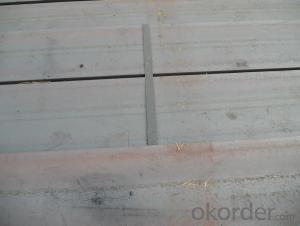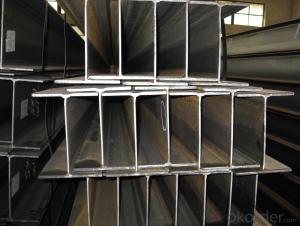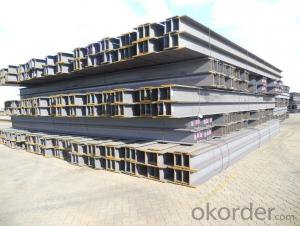Construction H beams/Ibeams GB standard/JIS standard EN standard
- Loading Port:
- Tianjin
- Payment Terms:
- TT OR LC
- Min Order Qty:
- 100 m.t.
- Supply Capability:
- 3000 m.t./month
OKorder Service Pledge
OKorder Financial Service
You Might Also Like
Packaging & Delivery
Packaging Detail:packed in bundle, suitable for sea transport (by container) or According to the clients`requirements
Delivery Detail:According to the actual weight
Specifications
joist steel
high quality and factory price
large inventories
short delievery time
good after-sales service
Country of Origin: China
Mill name: Ningbo Preah Vihear Steel Industry Co., Ltd.
Commodity: H beam
Tolerance: Strictly according to the G/B and JIS standard
Delivery time: within 30days
Price term: CIF/ CFR according to clients requirements
Payment terms: 100%Irrevercable L/C At Sight or TT
Product Description
ACCORDING TO STANDARD: JIS G3192 OR GB/T11263-2005
H beam Section sizenma(mm)Weight (kg/m)
Height×BreadthWeb thichnessFlange thichness
100×1006816.9
125×1256.5923.6
150×15071031.1
175×1757.51140.4
200×20081249.9
250×25091471.8
300×300101593.0
300×3001515105.0
350×3501219134.9
400×4001321171.7
148×1006920.7
194×1506929.9
244×17571143.6
294×20081255.8
340×25091478.1
390×3001016104.6
440×3001118120.8
482×3001115110.8
488×3001118124.9
582×3001217132.8
588×3001220147.0
100×50579.3
125×606813.1
150×755714.0
175×905818.0
198×994.5717.8
200×1005.5820.9
248×1245825.1
250×1256929.0
298×1495.5832.0
300×1506.5936.7
346×1746941.2
350×17571149.4
396×19971156.1
400×20081365.4
446×19981265.1
450×20091474.9
496×19991477.9
500×200101688.1
596×199101592.4
600×2001117103.4
700×3001324181.8
800×3001426206.8
900×3001628240.1
- Q:Can steel H-beams be used in educational institution construction?
- Yes, steel H-beams can be used in educational institution construction. Steel H-beams are commonly used in construction due to their strength, durability, and versatility. They can provide structural stability and support in various building applications, including educational institutions. H-beams can be used in constructing the framework of the building, such as columns and beams, as well as for floor support and roof structures. Additionally, steel H-beams can withstand heavy loads and have a long lifespan, making them suitable for educational buildings that require robust construction.
- Q:What is the lifespan of a steel H-beam in outdoor applications?
- The lifespan of a steel H-beam in outdoor applications can vary depending on various factors such as environmental conditions, maintenance, and quality of the steel. However, on average, a properly maintained and high-quality steel H-beam can last for several decades or even up to a century in outdoor applications.
- Q:Are Steel H-Beams suitable for art or cultural facility construction?
- Indeed, art or cultural facility construction can benefit from the use of Steel H-Beams. Given their robustness and resilience, Steel H-Beams have become widely adopted in the construction industry. Their exceptional ability to provide support and stability makes them particularly well-suited for the creation of expansive structures like art galleries, museums, and cultural facilities. Moreover, Steel H-Beams can be easily customized and fabricated to meet specific design criteria, thereby facilitating flexibility and innovation in the construction of artistic and cultural spaces. The adaptability of Steel H-Beams, coupled with their capacity to withstand substantial loads and withstand the elements, renders them a dependable option for the development of art and cultural facilities.
- Q:What are the aesthetic options for steel H-beams?
- Steel H-beams, also known as I-beams, offer a range of aesthetic options that can enhance the look and feel of various structures. Here are some of the aesthetic options available for steel H-beams: 1. Finish: Steel H-beams can be finished in various ways to achieve different aesthetic effects. One popular option is to leave the beams with a natural, raw steel finish, showcasing the industrial and rugged appeal of the material. Alternatively, the beams can be painted or powder-coated in different colors to match the overall design scheme of the structure or to create a contrasting visual effect. 2. Surface texture: Steel H-beams can also be treated to create different surface textures. For example, they can be sandblasted to achieve a rough, textured appearance that adds visual interest. Additionally, they can be polished or brushed to create a smoother and more refined look, which can work well in contemporary or modern architectural designs. 3. Coating: To enhance both aesthetics and durability, steel H-beams can be coated with various materials. One common option is galvanization, which involves applying a layer of zinc to protect the steel from corrosion. The galvanized coating can have a shiny or matte finish, depending on the desired aesthetic outcome. Other coating options include epoxy, which can be applied in different colors, or even a clear protective coating to preserve the natural appearance of the steel. 4. Shape customization: Steel H-beams can be customized into different shapes to suit specific aesthetic requirements. This includes altering the width, height, and thickness of the beams to create unique designs. Customized shapes can add visual interest and architectural appeal to structures, making them stand out in a visually striking manner. 5. Integration with other materials: Steel H-beams can be combined with other materials to create a visually appealing contrast. For instance, incorporating wood or glass elements alongside the steel beams can create an interesting mix of textures and materials, making the structure more visually dynamic. In summary, the aesthetic options for steel H-beams are vast and diverse. From different finishes and coatings to surface textures and shape customization, these options allow designers and architects to create visually appealing structures that cater to a range of architectural styles and preferences.
- Q:Can steel H-beams be used for industrial structures?
- Certainly, steel H-beams have proven to be a valuable option for industrial structures. In practice, they are widely utilized in the construction of a variety of industrial buildings and structures. These H-beams, which are also referred to as I-beams or universal beams, are specifically engineered to bear heavy loads and offer structural reinforcement. With a high strength-to-weight ratio, they are particularly well-suited for industrial applications where strength, durability, and stability are crucial. Warehouses, factories, power plants, and other industrial facilities frequently rely on steel H-beams to establish robust and dependable structures. Depending on the specific design requirements, these beams can be employed as columns, beams, or trusses. The adaptability of H-beams allows for diverse configurations and layouts, making them exceptionally suitable for a broad range of industrial construction projects. Moreover, steel H-beams provide numerous advantages over alternative construction materials. They possess fire-resistant, termite-resistant, and corrosion-resistant properties, ensuring the durability and longevity of the industrial structure. Additionally, steel is an environmentally sustainable and eco-friendly material as it can be recycled and reused, effectively reducing the environmental impact of the construction project. In conclusion, steel H-beams continue to be a favored choice for industrial structures due to their unparalleled strength, durability, and versatility. They offer the essential structural support and stability required for demanding industrial applications, making them an outstanding option for industrial construction projects.
- Q:Can steel H-beams be used in railway overpasses?
- Indeed, railway overpasses can utilize steel H-beams. Structural engineering and construction projects frequently employ steel H-beams owing to their remarkable strength and durability. These beams possess the capacity to bear substantial loads, making them an ideal choice for constructing bridges, including railway overpasses. The H-shaped design of the beam enhances its load-bearing abilities and facilitates efficient distribution of weight. Moreover, steel H-beams can be effortlessly fabricated and installed, rendering them highly favored for railway overpasses where strength and dependability are of utmost importance.
- Q:Can steel H-beams be used for observation towers?
- Yes, steel H-beams can be used for observation towers. Steel H-beams are commonly used in construction and have the strength and stability required for building tall structures such as observation towers. They provide a sturdy framework that can support the weight of the tower and offer a secure platform for observation purposes.
- Q:How do you calculate the section modulus of steel H-beams?
- To calculate the section modulus of steel H-beams, you need to determine the moment of inertia of the cross-sectional area of the beam and divide it by the distance from the neutral axis to the outermost fiber. The formula for section modulus is Z = I / c, where Z is the section modulus, I is the moment of inertia, and c is the distance from the neutral axis to the outermost fiber.
- Q:Can steel H-beams be used in seismic retrofitting?
- Seismic retrofitting, which reinforces existing structures to withstand seismic activity, can indeed utilize steel H-beams. These beams are frequently employed in seismic retrofitting due to their exceptional strength and flexibility. By employing steel H-beams in seismic retrofitting, seismic forces can be redistributed, effectively reducing the risk of structural damage during an earthquake. These beams are designed to absorb and dissipate the energy generated by seismic waves, preventing structural collapse. Moreover, steel H-beams can be easily installed and integrated into existing structures, making them a popular choice for seismic retrofitting projects. They can be bolted or welded to the existing framework, providing additional support and stability. Furthermore, engineers can choose from a variety of sizes and shapes of steel H-beams, enabling them to select the most appropriate beam for a specific retrofitting application. This versatility ensures that the retrofitting process can be customized to meet the unique requirements of each structure. In conclusion, steel H-beams are an ideal choice for seismic retrofitting due to their high strength, flexibility, easy installation, and wide range of options. They play a critical role in enhancing the seismic resilience of existing structures, ensuring their safety and durability in regions prone to seismic activity.
- Q:Can steel H-beams be used in industrial applications?
- Yes, steel H-beams can be used in industrial applications. H-beams, also known as I-beams or W-beams, are structural steel beams with a cross-section resembling the letter "H". They are commonly used in industrial construction projects such as the construction of buildings, bridges, and infrastructure. Steel H-beams offer several advantages that make them suitable for industrial applications. Firstly, they provide excellent structural support and load-bearing capabilities, making them ideal for heavy-duty applications. H-beams have a high strength-to-weight ratio, allowing them to withstand large loads while remaining relatively lightweight. This strength is crucial in industrial settings where heavy machinery, equipment, or materials need to be supported. Additionally, steel H-beams have excellent durability and resistance to various environmental factors. They are highly resistant to corrosion, which is important in industrial applications where exposure to moisture, chemicals, or harsh weather conditions is common. The durability of steel H-beams ensures their long lifespan and minimal maintenance requirements, making them a cost-effective choice for industrial projects. Moreover, H-beams are versatile and can be fabricated to meet specific design requirements. They are available in a variety of sizes, lengths, and thicknesses, allowing engineers and architects to choose the appropriate beam dimensions for their industrial applications. This versatility enables the customization of H-beams for specific load-bearing capacities, spans, and structural requirements. In conclusion, steel H-beams are widely used in industrial applications due to their excellent structural support, high strength-to-weight ratio, durability, resistance to corrosion, and versatility. These features make them an ideal choice for various construction projects, ensuring the safe and efficient operation of industrial facilities.
1. Manufacturer Overview |
|
|---|---|
| Location | |
| Year Established | |
| Annual Output Value | |
| Main Markets | |
| Company Certifications | |
2. Manufacturer Certificates |
|
|---|---|
| a) Certification Name | |
| Range | |
| Reference | |
| Validity Period | |
3. Manufacturer Capability |
|
|---|---|
| a)Trade Capacity | |
| Nearest Port | |
| Export Percentage | |
| No.of Employees in Trade Department | |
| Language Spoken: | |
| b)Factory Information | |
| Factory Size: | |
| No. of Production Lines | |
| Contract Manufacturing | |
| Product Price Range | |
Send your message to us
Construction H beams/Ibeams GB standard/JIS standard EN standard
- Loading Port:
- Tianjin
- Payment Terms:
- TT OR LC
- Min Order Qty:
- 100 m.t.
- Supply Capability:
- 3000 m.t./month
OKorder Service Pledge
OKorder Financial Service
Similar products
New products
Hot products
Related keywords





























